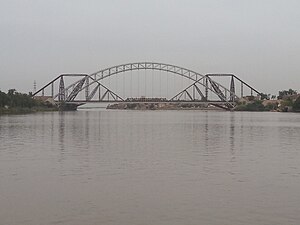Lansdowne Bridge
Coordinates: 27 ° 41 ′ 38 ″ N , 68 ° 53 ′ 18 ″ E
| Lansdowne Bridge | ||
|---|---|---|
| Photo from The Queen's Empire , 1897–1899 | ||
| use | former railway bridge | |
| Crossing of | Indus | |
| place | Sukkur - Rohri | |
| construction | Gerber girder bridge | |
| overall length | 366 m | |
| Number of openings | a | |
| Longest span | 250 m | |
| Construction height | 52 m | |
| start of building | 1887 | |
| opening | March 25, 1889 | |
| planner | Alexander Meadows Rendel | |
| location | ||
|
|
||
| Lansdowne Bridge, in front of it the Ayub Bridge (1962) | ||
The Lansdowne Bridge in Pakistan connects the cities of Sukkur in the province of Sindh on the northwest and Rohri on the southeast bank of the Indus .
It was built by the British in what was then British India in the late 1880s to close the last section of the Lahore - Karachi line of the North Western State Railway . After the Attock Bridge , which is around 755 km upstream as the crow flies , it was the second bridge over the Indus. Until the opening of the Forth Bridge in Scotland the following year, it was the largest tanner girder bridge in the world.
It was named after Lord Lansdowne , the Viceroy of India at the time .
The Lansdowne Bridge lost its importance in 1962 when the Ayub Bridge with its large arch immediately next to it took over the railway traffic and in the early 2000s the Sukkur Bypass below the Sukkur Barrage took over a large part of the road traffic.
description
The Indus is forced into a narrow bed by the hills of Sukkur and Rohri and is also divided into two arms by Bukkur Island, so that this place was ideal for crossing the broad river by two individual bridges.
Lansdowne Bridge
The south-eastern arm, known as the Rohri Pass , has a bed of sediments on which at least at that time no piers could be built and therefore had to be crossed with a span. After various designs that were rejected as unsatisfactory, the design of a single-track tannery girder bridge by Sir Alexander Meadows Rendel was finally accepted, the steel parts of which were manufactured by Westwood, Baillie in what is now the London district of Poplar , assembled on a trial basis and then shipped to India and transported to the construction site. The installation was carried out under the direction of FE Robertson and Hecquet.
The superstructure is striking because of its two 52 m (170 ft) jibs rising above the abutments , the essential elements of which are two vertical and diagonal supports each reminiscent of the cargo booms of ships. The booms protrude 94.5 m (310 ft) over the river, between them a 61 m (200 ft) long truss is suspended. The entire structure is 366 m (1200 ft) long.
The Lansdowne Bridge was inaugurated on March 25, 1889 by Lord Reay , the governor of Bombay as representative of the viceroy.
In 1910 and again in 1939 the bridge was reinforced to adapt it to the increased traffic loads. Since the opening of the Ayub Bridge in 1962, it has been used for road traffic. In the last few years she seems to have been left to herself.
Sukkur Bridge
The north-western arm, known as Sukkur Pass , has a rocky subsoil, so that the Sukkur Bridge with two river piers could be built there. The steel superstructure consists of two truss arches and a shorter beam girder with spans of 85 m (278 ft ), 72.5 m (238 ft) and 28.8 m (94 1/2 ft). This bridge was completed in 1885.
Web links
Individual evidence
- ^ The Lansdowne Bridge over the Indus at Sukkur . In: The Engineer , Volume 70 (December 12, 1890), p. 471 f ( digitized from Grace's Guide)
- ↑ a b c Owais Mughal: Lansdowne Bridge at Sukkur . To irfca, the Indian Railways Fan Club
- ^ Sarfaraz Memon: An abandoned landmark: With no takers, Lansdowne Bridge stands on its own. Article from October 19, 2013 on tribune.com
- ↑ Historical photo of the Sukkur Bridge on staticflickr
- ^ Bridge over the Indus at Sukkur . In: The Engineer , Volume 71 (January 2, 1891), pp. 8, 10 ( digitized from Grace's Guide)


